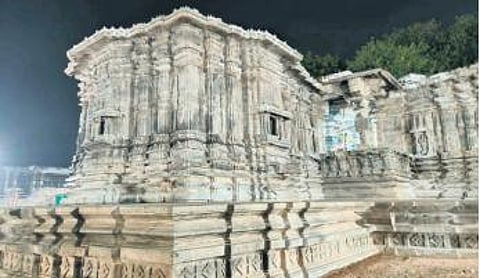

HYDERABAD: As we began to jot down the major markers of heritage on the cultural and geographical tapestry of Hyderabad and Telangana, we found that heritage walks were an important component in our reconnaissance of the city. Tagging along with The Deccan Archive (TDA), Indian National Trust for Art and Cultural Heritage (INTACH), and The Hyderabad Walking Company (THWC), we explored the city and its outskirts, gaining insight into our shared history and culture.
We recollect Anuradha Reddy, the co-convener of INTACH Telangana saying, “When you are on the ground, cycling or walking, you connect and become familiar with your surroundings. You start collecting memories that become an integral part of your life, especially when you live in the same place for a long time.”
Just a month before Ramzan, we headed out on a one-day trip to Bidar, unravelling its connection with Hyderabad. A historic city, about 143 km away from Hyderabad, it is known for Bidriware metalcraft and boasts a diverse cultural heritage dating back centuries. We visited the tomb of Sufi saint Khalil-Ullah Kirmani, known as Chaukhandi, on the outskirts of Ashtur town, followed by the Bahmani tombs at Ashtur. Then we saw the Madrasa of Mahmud Gawan, once a splendid educational complex but now houses only the vestiges of that grandeur. We also explored the formidable Bidar Fort with its amazing acoustics and palaces.
During Ramzan, we explored some old and new eateries in the Nampally-Mallepally area with TDA and THWC, devouring some delightful delicacies such as seekh kebabs, talawa ghosht, haleem, mutton chakna, patthar ka ghosht, burhanpur ki jalebi and mulberry custard. Shedding some light on the planned development in the area, Sibghat Khan, founder of TDA, informed us about the 1908 Musi floods, which led the City Improvement Board to construct model houses around Afzal Sagar in the 1970s. We also visited the volleyball playground built in memory of Abdul Basith Siddiqui, an international volleyball player, captain of the national men’s volleyball team, and who represented India twice in the Asian Games.
Nampally, also rich in Sufi heritage houses many dargahs and shrines that have stood the test of time. We explored three prominent dargahs in the area: Dargah-e-Shah Khamosh, Dargah-e-Yousufain, and Aghapura Dargah. Hazrat Shah Khamosh, a Sufi saint, as the legend goes, maintained a vow of silence for 25 long years, which earned him the name ‘Shah Khamosh.’ The dargah is his final resting place, built in neo-gothic style. The lively and bustling Dargah-e-Yousufain complex pays homage to Baba Yousuf and Baba Sharif, who arrived in Hyderabad as part of Mughal emperor Aurangzeb’s army camp in the 17th century.
The vibrant atmosphere of the dargah resembles a traditional fair. Flower-sellers and pakoda-bhajia vendors call out to passersby in loud voices, creating an ambiance that is both chaotic and beautiful. Aghapura owes its name to Agha Muhammad Dawood Abul Ulai, a disciple of the Sufi saint Shah Mohammed Hassan Abul Ulai. Behind the primary dargah building, there is a 200-year-old Khankha, a dedicated place for the gathering of the Sufi Brotherhood. It is a haven for spiritual retreat and prayer, with cusped arches adorning its structure. The shrine, the hospice, the dining hall, and the sama khana, are all adorned with hand-crafted chandeliers, adding to the grandeur of the sacred space.
The sama khana is a place where qawalis are held in reverence of the saint and in prayer to God. In November, we revisited some well-known Kakatiyan marvels on another day trip. We first headed to the historic Ramappa Temple in the Mulugu district, recognized as a UNESCO World Heritage site. The other places we explored were the Warangal Fort and Thousand Pillars Temple. Primarily a Shiva temple, with the presiding deity being Ramalingeshwara Swamy; many elements in the Ramappa temple are similar to those found in the Jaina tradition. What is drastically evident within the temple is the impact of a major earthquake that occurred some five centuries ago. As we reached the Warangal fort, we saw four rectangular portals in four directions enclosing an open field where the ruins from various monuments had been collected and put together for display and conservation. These four intricately carved portals are also the emblems of Telangana. Known as Kala Thoranams, these later served as conceptual inspirations for the four arches around Charminar of Hyderabad.
Last month we also started our weekly section, ‘Culture Imprints’ highlighting specific artifacts and places of significance, owing to the historical and cultural heritage of Hyderabad. Within those columns, we covered the Deccan school of miniature paintings, characterized by the minutest of details, retelling stories of epic proportions. The composite figures found in these paintings highlight the complex visual discourses that artists and painters indulged in. We also looked at the double statue at the Salar Jung Museum and remembered Monsieur Raymond, also known as Moosa Rehmu. We would continue to explore this city that encompasses a rich and vast cultural landscape, with the hopes that would join us in this journey too!